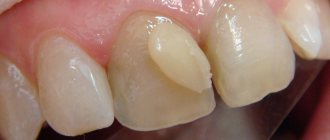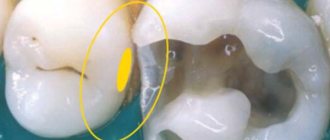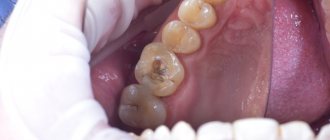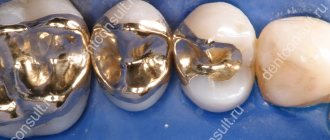When a tooth is destroyed, caries forms, or a filling is lost, the question of filling arises. Any defect in dentistry can be replaced using various types of fillings . Conservative therapeutic intervention allows you to stop the spread of caries and maintain an aesthetic appearance.
Dental clinics today use various types of materials : cement, plastic, ceramics, photopolymer components. One filling material is suitable for the front teeth, the other for the lateral and chewing elements of the dental system. In each case, the choice takes into account the clinical picture, the degree of pathology and possible contraindications.
Classification of filling materials
Depending on its purpose, the filling composition can be temporary or permanent. For the first, a less durable material is used, since the dental filling is designed for a short period. It is usually installed in cases of pulpitis to isolate the diseased unit. Permanent ones are made from more durable materials; they are usually designed to last for several decades. The process of setting them up is longer and more scrupulous. Let's take a closer look at each of the options.
Temporary filling
A filling composition that is diagnostic. It is made from artificial dentin using special medicinal additives. The main purpose is to isolate the tooth cavity. It performs an important protective function, preventing the spread of infection and the accumulation of food debris. It is usually installed before nerve extraction. The doctor removes damaged enamel and dentin, cleans the canals, and then installs a special dental filling made of a certain material.
The temporary filling material must meet the following criteria.
- Effective sealing.
- Resistance to the influence of medicinal drugs.
- Easy to remove.
- No allergic reactions or toxic effects.
- Excellent ductility.
- Fast hardening properties.
A temporary filling composition is installed for a certain period of time, from a couple of days to several weeks. What material are these fillings made of? most often used in clinics are Vinoxol, Sympath and special cement-containing compounds. Their advantages include the fact that they do not have a negative effect on the tissue of the dentition element, they have good adhesion and sealing properties.
Permanent filling
The filling material is characterized by increased strength and wear resistance, and has the required coefficient of thermal expansion. Various types of permanent dental fillings are installed for a long time. Their main task is to hermetically seal the cavity of an element of the dental system, protect against the spread of a pathogenic environment and give the dental unit an impeccable appearance. In each case, a suitable option is selected. For example, for chewing dental units, various types of cement fillings are used, and for the anterior ones, compositions based on photopolymers are used.
Modern filling materials for permanent fillings must meet certain requirements.
- Good adhesion. Excellent connection with the tissues of the dental unit.
- No toxic effects on the body.
- Increased resistance to any chemical attack.
- Mechanical strength. The light-polymer filling must withstand significant loads.
- Good marginal seal. The composition should adhere tightly to the walls of the arious cavity and adjacent tissues.
- Increased wear resistance. Composite filling materials should not lose their properties when in contact with abrasive substances.
- High aesthetic performance.
When using various dental compounds, it is important to follow standards, regulations and relevant protocols. This will ensure a long service life of the filling component.
We looked at what fillings are and what important characteristics they must meet. In each case, you should consult a specialist. The doctor will be able to explain the difference between a gutta-percha filling and a light-polymer filling. In each case, functional load, possible diseases and contraindications are taken into account.
Features of the choice of materials
When choosing materials, the following criteria must be taken into account:
- safety, compatibility with natural tissues;
- high levels of strength, elasticity, hardness, the ability to quickly recreate the natural shape of the unit;
- aesthetics;
- the size of the pathology, the location of the cavity and the requirements for correction or restoration;
- light or chemical method of material hardening;
- price;
- degree of tissue preservation.
Service life depends on the material used. Most often, it is 2-10 years for a standard filling, 2 years for phosphates, 3-4 for composites and silicate, 4 years for glass polymers. The longest periods are observed for self-curing composites and photopolymers – 10 years. At the same time, the duration is influenced by such factors as the presence of loads, the size of the pathology, compliance with the rules of oral care and diet, and regular visits to the dentist for preventive examinations.
Types of materials for dental fillings
Dental clinics today use various filling compounds. More information about the names of fillings and materials used can be obtained directly from your doctor. Filling materials are made based on the following components:
- Amalgam. A metal filling compound that is strong and durable. Quite rarely used in practice. The advantages include strength and abrasion resistance. The disadvantages are unaesthetic and the risk of developing allergies. There are contraindications.
- Cement. The main material for chemical fillings. The most commonly used powder is zinc oxide with the addition of silicon and magnesium. The advantages are affordable cost, ease of installation, and reduced risk of developing recurrent caries. The downside is quick erasing and poor aesthetics.
- Plastic. Composite product for durability and reliability. The best option when you don’t know what filling to put on a tooth and have a limited budget. Compositions based on acrylic acids are especially popular. They are distinguished by good durability and the ability to select colors. The downside is the high risk of microscopic pores.
- Photopolymers. Light-curing filling materials are the most popular today. The paste mixture hardens under the influence of ultraviolet light. The advantages are natural shine, strength, aesthetics, minimal toxicity. A light seal made of photopolymer material is practically free of disadvantages.
- Composites. Plastic products with special inorganic fillers. Among them is a gutta-percha filling. It is distinguished by strength, indelibility, and resistance to external factors. Used as a filling material for root canals.
- GIC (glass ionomer cements). High-strength filling material used for fixing crowns. Has excellent adhesion to metal and ceramic products.
More information about glass ionomer and light-based fillings can be obtained directly from your dentist. The choice of filling composition must be approached responsibly and trusted by your attending physician, since the performance of the chewing function will depend on this. At our AlphaDent dental clinic you can get detailed advice on selecting the necessary filling to suit your individual characteristics.
Why is light filling considered the best?
Thanks to the advent of fillings made of light-curing composite, the quality of dental treatment has been raised to the highest level. A special material is used for them. It hardens only under the influence of a special lamp. The material has characteristics that allow a specialist to form the desired shape and adapt it to the required conditions.
The composite has earned excellent reviews in dentistry thanks to:
- long service life;
- aesthetic characteristics, which make it possible to carry out restoration even on the front teeth;
- health safety;
- the ability to choose a shade that will best match the natural color;
- virtually instant hardening.
Today, dentistry uses various composite compounds, which are produced in the USA, Japan, and Europe. One of the best is Enamel filling material, developed by Micerium SpA
But in case of severe destruction, tooth restoration will require more than just filling material. To strengthen the structure, it is necessary to use a pin.
Basic materials for filling
If we classify filling materials according to their intended purpose, they can be divided into 4 main groups:
- permanent - restore the shape of the tooth;
- temporary - to close a carious cavity for the duration of treatment);
- cushioning (therapeutic, insulating);
- used for filling canals;
Material for filling root canals
Root canal filling is complicated by the fact that the filling material is located in close proximity to the internal tissues of the teeth. In this regard, there is a need for its “exceptional” properties:
- do not dissolve in tissue fluid;
- do not cause irritation;
- have radiopacity (stand out on a radiograph);
- easy to remove.
Gutta-percha is widely used for obturation (clogging) of root canals. Gutta-percha pins have a standard conical shape and dimensions corresponding to a special instrument (K-reamer), which allows achieving maximum quality of endodontic manipulations.
For retrograde filling, when a surgical incision is made behind the apex of the tooth root, glass ionomer cements are used. The use of other materials that are more complex in application technique is impractical, since with them it will be impossible to achieve the required tightness.
What is tooth extension on a pin?
A pin is a small rod whose purpose is to strengthen the entire structure. It is installed in the root canal.
Tooth extension onto a pin may be required if:
- chipped teeth and cracks;
- enamel damage;
- violation of the integrity of the tooth as a result of trauma;
- loss of part of the tooth surface as a result of caries.
The most commonly used pins are:
- anchor - made from high-strength materials, they allow you to restore even the most severe damage. An important condition for their installation is healthy root canals;
- fiberglass - hypoallergenic and safe. Their main advantages are that they are easy to install, not subject to discoloration and corrosion;
- titanium - used when it is necessary to restore large damage.
The design of the pin is selected depending on the degree of destruction, as well as in accordance with the wishes and financial capabilities of the patient.
Filling baby teeth
In pediatric dental practice, both phosphate cements and compomers - composites combined with glass ionomers - are used as permanent filling materials.
Both have the ability to enrich tooth tissue with fluoride, but the latter are more resistant to destruction and have high aesthetic characteristics. Some dentists use chemical-curing compounds with colored components to make fillings for children.









